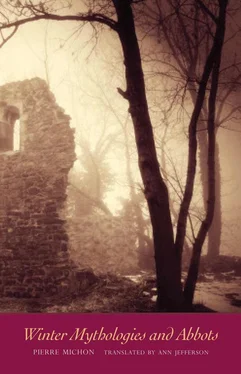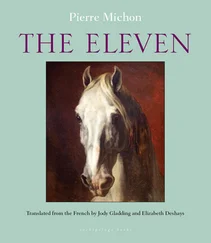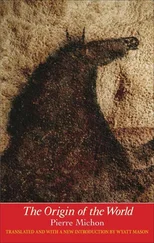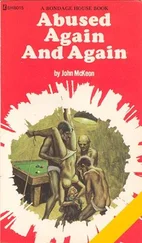She has ridden through the wood, and left her horse at the harbor. It’s already five o’clock in winter, she can hear the evening psalms being sung up above. Torches are running hither and thither in the forest, people searching for her. The moon is tiny. She unties a barge and reaches the current in the river. Her elation hasn’t left her: she is laughing, her soul thirsting for obedience to a sinister fate. She disrobes, throws velvets and fur-lined cloak into the water. Around her waist she has kept the sign, the two hands’ width of tightened boar hide. It was a sign, but she read it wrong. It wasn’t God’s boar. It was a boar that begat Gaucelin, begat the ancient altar, begat the priory, begat the charters and the viscountess of Thouars, begat crime, and is about to beget her death. It was Emma’s boar. The spire above the choir gleams in the moonlight; a monastery is not a woman any more than a boar is an envoy from God. She is also elated by her mistakes, and she can see the truth alongside them, stripped of signs. All things are mutable and close to uncertain. She throws herself into the water; she sinks to the bottom, then into the wallow of the mud where she will never be found.
Or else, on the following day, she is washed up downriver on the shore of the island of Champagné, near a village of yokels whom Pierre describes as cruel, unbiddable, and barbarous. The yokel who finds her goes to fetch one of the boathooks used to haul in big fish; he returns with a few other men, and using the tip of the boathook they push the body back into the current, bloated like a leather bottle and still with the pig hide that has almost sliced it in two. They wonder whether it’s a man, a woman or a pig. They laugh. The leather bottle is swept away downstream.
It is once again to Petrus Malleacensis — who wrote his Chronicle under the rule of Goderan, the fourth abbot of Maillezais, also appointed from Cluny, the saltworks of the earth, at a time when he (Pierre) was growing old, for he took his vows under the abbacy of Theodelin, lived through the exceptionally long abbacy of Humbert, and was still there, effective and in full possession of his wits since Goderan chose him for this long-term undertaking — in other words, to the inexhaustible Chronicle of Maillezais and also to the Intransitive Chronicles of Adémar de Chabannes, whom posterity knows better than Pierre, a delightful and ambitious man of letters, something of a forger, and a Limousin by birth, who oversaw a faked, devious, incontrovertible Life of Saint Martial , to these two authors, the one obscure and the other renowned, that I owe the following history.
Young Pierre, the scribe, is on the road to Charroux with some ten black monks on muleback in the dreary countryside, for Adémar says that it’s October, and it’s hard to make out the monks, blurred by the driving rain, for Adémar also mentions that it was a year of excessive rains, when the rivers burst their banks. Theodelin is riding one of the mules. He’s old. He has raised buildings, fought for power, and kept it; he had Guillaume Fierabras in the palm of his hand, where he now has his son Guillaume, the Great, but he’s not tired, he’s enchanted by this trip to Charroux in the pouring rain. He appears to me in the form of a small, swarthy man whose hair is scarcely grayed, brusque, expansive, and brooding by turns, who limps a little when he is not on muleback. Pierre says he is a Hebrew by nation but clothed in Gallic piety, by which he doubtless means excessively preoccupied with detail, as converts are, persnickety about ritual, and, since he was born among the nation that has no idols, particularly idolatrous, with the specific idolatry that is tolerated and blessed by the saltworks of Cluny, the one devoted to saints, their lives, and their remains.
The era, as we know, loves bones. Not all bones — they’re careful to choose; they argue and sometimes kill one another over these choices: only the bones that can be arrayed in a text — the Text written a thousand years ago, or the texts written a hundred years previously, or the text that was written for them the minute before — the bones that Cluny or Saint-Denis have named and sealed, those that, according to patently visible signs which are now illegible to us, were once part of a human frame from which the word of God emanated, the human frame of a saint. How they decided that one bone was to be dressed and named, displayed in gold before the eyes of men, and that another, anonymous and naked, was fit only for the blind earth we cannot understand, and only the words cynicism or utter credulity come to mind, but certainly not the words knowledge and truth . We gawp at these reliquaries in the depths of cold churches (you have to place a coin in a slot for them to emerge from the shadows), we gawp at the little notice that summarizes the saint’s life which is always fundamentally the same one; the nuances escape us as they have escaped the writer of the notice; we are bored long before the little bulb goes out, the black calcium carbonates glimpsed through the grimy little window revolt us — and the artistry of the reliquaries is not particularly complicated, despite the thickness of the catalogues intent on proving that it is. We’ve seen the signs which no longer signify. But as we step out into the sunshine and look toward the carpark in front of the church, if five o’clock is striking in the tower above our heads, or if a few birds fly up or a wing mirror dazzles us, a mixed elation takes hold of us because on this same portico in the sunshine the thing we cannot understand — the bone and the gold and the written words all mixed together — was brandished by cynical or knowledgeable prelates before credulous or genuine crowds who were deeply affected by it. Inside the car we leaf through the thick catalogue of national museums which we do believe in, whether out of cynicism or credulity. We drive off in the October sunshine, and in an October downpour Theodelin and his monks arrive at Charroux.
There’s a great gathering of bones. Martial has been brought from Limoges, his skeleton complete right down to the last metacarpal, as Adémar ensured; Valérie, whose head is all there is; and also the head alone of Saint Hilaire, the arms of Saint Stephen which were broken by stones, and many others. But all these bones matter only for their number: they’ve been brought to worship and vouch for an extraordinary bone, a bone from before the New Covenant, before the Text itself, the intact skull of John the Baptist, the specimen displayed on the platter in Machaerus when Salome danced and Herod drank. All the relics are there in the choir, but not the extraordinary head; it’s been locked away no one knows where, the better to reveal it at the Feast of the Nativity of Saint John the Baptist, five days before All Souls’. All the prelates in the world are there, all the abbots in black, the kings — Robert, king of France, and the king of Aragon, Sancho of Navarre — all the dukes and the counts, and each day the great and powerful men of this world walk with their relics through the marveling rain-soaked crowds from Poitou, the Limousin, and Aquitaine. The head of the Baptist was found by Abbot Audouin of Angély during the demolition of the old entrance to his basilica, which was collapsing: the masons came to fetch him and led him to a stone chest set into the stone of the entrance, but of a different kind. The chest was opened, and inside there was a plain silver ball, the top of which could be lifted off, as it duly was, to reveal a skull and these words written on the inside of the lid: Here reposes the head of the Forerunner . Outside in the rain people are waiting patiently for the head.
Читать дальше











